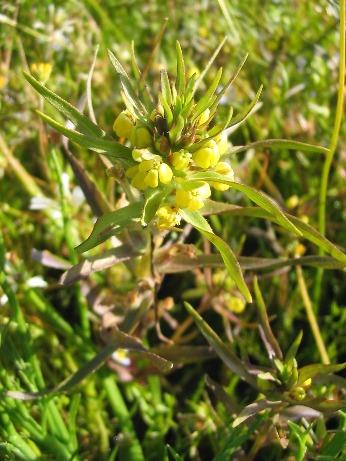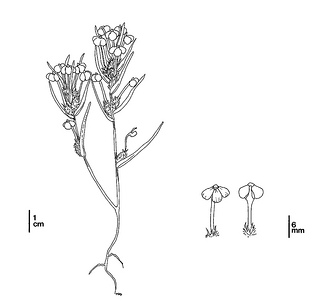(Castilleja campestris ssp. succulenta)
 Castilleja campestris ssp. succulenta. CDFW photo by Reagen O'Leary.
Castilleja campestris ssp. succulenta. CDFW photo by Reagen O'Leary.

Castilleja campestris ssp. succulenta . CDFW illustration by Mary Ann Showers. (Click to enlarge)
Succulent owl’s clover is a California endangered plant species, which means that killing or possessing the plant is prohibited by the California Endangered Species Act (CESA). Succulent owl’s clover is a small herbaceous annual plant found in vernal pools of the eastern San Joaquin Valley of the Southern Sierra Foothills Vernal Pool Region. It is hemiparasitic, meaning it forms root grafts with host plants to obtain water and nutrients, but makes its own food through photosynthesis. Flowering typically occurs between April and May. Succulent owl’s clover is also listed as threatened under the federal Endangered Species Act.
At the time of this webpage posting, the California Natural Diversity Database lists 91 occurrences of succulent owl’s clover, 89 of which are presumed to still exist. About two-thirds of the occurrences are located in eastern Merced County, with its range extending from northern San Joaquin County to Fresno County. There are 22 protected occurrences of succulent owl’s clover in Merced County, including populations protected by conservation easements as a result of the development of the University of California Merced campus. Succulent owl’s clover occurs in vernal pools with a variety of characteristics including small and large pools, bowl-shaped pools and swales, shallow and deep pools, and pools with short and long inundation periods.
Like other vernal pool species, urbanization, development, agricultural conversion, and other human activities are the largest threats to succulent owl’s clover. Vernal pool habitat has been reduced and fragmented throughout California. Existing vernal pool habitat is often located close to cities and agricultural lands which could negatively affect the hydrology of the remaining vernal pools. Although there are many protected occurrences in Merced County, the high rate of development in the area continues to threaten habitat of succulent owl’s clover, and indirect consequences of development may threaten protected occurrences as well. Additionally, many occurrences of succulent owl’s clover have low population numbers and are therefore more vulnerable to extirpation. Impacts of climate change also threaten succulent owl’s clover. To ensure long-term conservation of succulent owl’s clover, the U.S. Fish and Wildlife Service’s Recovery Plan for Vernal Pool Ecosystems of California and Southern Oregon (PDF) recommends habitat protection, adaptive habitat management and monitoring, status surveys, and research to identify actions necessary for the recovery of the species.
CDFW may issue permits for succulent owl’s clover pursuant to CESA, and you can learn more about the California laws protecting succulent owl’s clover and other California native plants. Populations of succulent owl’s clover occur in CDFW’s North Central Region and Central Region.
Updated 12/8/2015